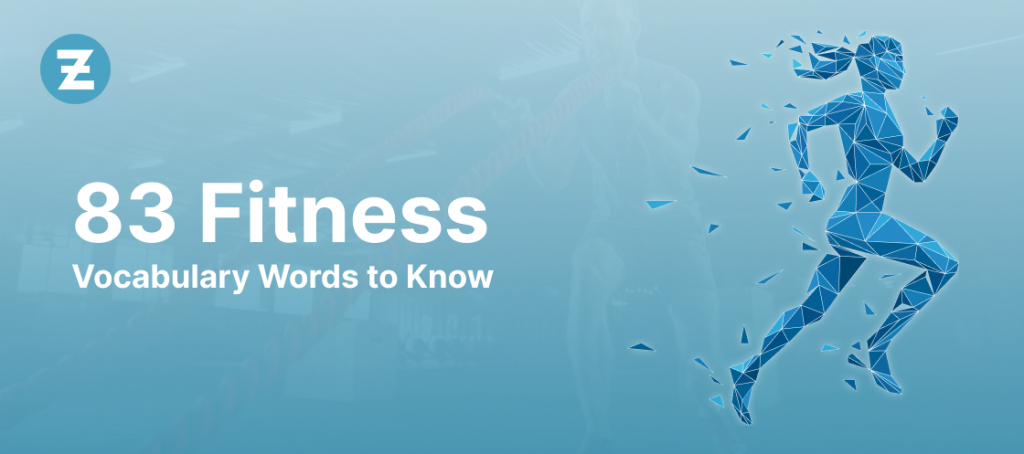Are you ready to take your fitness journey to the next level?
Whether you’re a seasoned gym-goer or just starting, one thing can greatly enhance your fitness experience: expanding your fitness fluency.
By adding essential words to your fitness vocabulary, you’ll sound more knowledgeable and have a deeper understanding of various exercises, training techniques, and fitness concepts.
In this blog, we’ll be sharing 83 essential words that will help you improve your fitness fluency.
So, let’s dive in and start expanding your fitness vocabulary!
Read Also: Landscape Vocabulary Words
83 Fitness Vocabulary Words
-
Fitness
“Fitness” refers to the overall state of being physically healthy and having the ability to perform daily activities with vigor and alertness.
It encompasses various aspects, including cardiovascular endurance, muscular strength, flexibility, and body composition.
Being physically fit improves one’s quality of life, energy levels, and reduces the risk of chronic diseases.
-
Exercise
“Exercise” is any planned, structured, and repetitive physical activity that aims to improve or maintain physical fitness.
It can include activities like running, swimming, cycling, weightlifting, and more. Regular exercise is essential for promoting cardiovascular health, muscle strength, flexibility, and mental well-being.
-
Workout
A “workout” is a specific session of physical exercise or training. It often involves a combination of different exercises targeting various muscle groups or aspects of fitness.
Workouts can be tailored to individual goals, such as improving strength, endurance, flexibility, or achieving specific fitness milestones.
-
Physical activity
“Physical activity” is any bodily movement that requires energy expenditure. It includes both planned exercise sessions and everyday activities like walking, climbing stairs, gardening, or household chores.
Engaging in regular physical activity contributes to overall health and well-being.
-
Cardiovascular
“Cardiovascular” relates to the heart and blood vessels, particularly the circulatory system.
Cardiovascular exercises, also known as aerobic exercises, increase the heart rate and breathing rate over an extended period.
These exercises improve cardiovascular endurance, lung capacity, and overall heart health.
-
Strength training
“Strength training” or “resistance training” involves exercises that aim to strengthen and tone muscles by working against resistance.
This resistance can be provided by free weights, resistance bands, weight machines, or bodyweight. Strength training helps build muscle mass, increase bone density, and improve overall strength and function.
-
Endurance
“Endurance” refers to the ability of the body to sustain physical activity for an extended period without fatigue.
It is commonly associated with cardiovascular fitness and is measured by how long one can engage in activities like running, swimming, or cycling without getting tired.
Endurance training improves stamina, cardiovascular health, and overall efficiency in physical tasks.
-
Flexibility
“Flexibility” is the range of motion in a joint or a group of joints. It refers to the ability of muscles and tendons to stretch and move freely without causing injury or discomfort.
Stretching exercises, such as yoga and Pilates, help improve flexibility, making movements easier and reducing the risk of muscle strain.
| Upgrade your English pronunciation and listening abilities with Zoundslike’s interactive learning platform! |
-
Agility
“Agility” is the ability to change body position quickly and efficiently while maintaining balance and control.
It is essential in sports and activities that require quick directional changes and swift movements. Agility training involves exercises that enhance coordination, reaction time, and spatial awareness.
-
Balance
“Balance” refers to the ability to maintain a stable and controlled body position during both static (stationary) and dynamic (moving) activities.
Good balance is crucial for everyday activities, as well as sports and exercises that require stability, such as yoga and weightlifting. Balance exercises help improve core strength and prevent falls and injuries.
-
Aerobics
“Aerobics” is a type of cardiovascular exercise that involves continuous and rhythmic physical activity, typically performed at moderate intensity.
It includes activities like dancing, step aerobics, and cardio workouts. Aerobic exercises improve cardiovascular endurance, burn calories, and strengthen the heart and lungs.
-
Pilates
“Pilates” is a low-impact exercise system that focuses on strengthening the core muscles, improving flexibility, and enhancing body awareness and control.
It involves a series of precise movements and controlled breathing patterns. Pilates helps develop long, lean muscles, improve posture, and promote overall body alignment.
-
Yoga
“Yoga” is a mind-body practice that originated in ancient India and includes physical postures, breath control, meditation, and relaxation techniques.
Yoga promotes flexibility, strength, balance, and mindfulness. It is beneficial for reducing stress, improving mental focus, and enhancing overall well-being.
-
CrossFit
“CrossFit” is a high-intensity fitness program that incorporates elements from various sports and exercise disciplines.
It focuses on functional movements and aims to improve cardiovascular endurance, strength, flexibility, power, speed, coordination, and more. CrossFit workouts are typically varied and challenging.
-
Repetitions (reps)
“Repetitions” or “reps” refer to the number of times a specific exercise is performed consecutively before taking a rest or moving on to another exercise.
For example, if someone performs 10 push-ups, “10 reps” means they completed the exercise 10 times.
-
Sets
“Sets” refer to a group of repetitions performed one after the other, with a short rest in between.
For example, if someone does 10 push-ups, takes a break, and then does another 10 push-ups, that would be 2 sets of 10 reps each.
-
Intensity
“Intensity” in fitness refers to the level of effort or exertion put into an exercise or workout. It can be measured by factors like heart rate, resistance, or the amount of weight lifted.
High-intensity workouts involve pushing yourself to work at a challenging pace, while low-intensity workouts are more relaxed and gentle.
-
Resistance
“Resistance” in fitness is the force that acts in the opposite direction to the movement of a muscle during an exercise.
It can come from bodyweight, free weights (such as dumbbells and barbells), resistance bands, or weight machines. Resistance training helps build strength and muscle mass.
-
Dumbbell
A “dumbbell” is a handheld weight used for resistance training. It consists of a short bar with weights attached at each end.
Dumbbells come in various sizes and can be used for a wide range of exercises to target different muscle groups.
-
Barbell
A “barbell” is a long metal bar with weights attached to both ends. It is a versatile piece of equipment commonly used in weightlifting and strength training exercises.
Barbell exercises often involve compound movements that engage multiple muscle groups.
Read Also: 187 American Slang Words You Need to Know in 2023
-
Treadmill
A “treadmill” is a stationary exercise machine with a moving platform or conveyor belt on which a person can walk, jog, or run in place.
It allows individuals to engage in cardiovascular exercise indoors, simulating the experience of walking or running outdoors.
-
Elliptical
An “elliptical” or “elliptical trainer” is a stationary exercise machine that simulates movements similar to walking, running, or climbing stairs, but with reduced impact on the joints.
It provides a low-impact cardiovascular workout and also engages both the upper and lower body.
-
Stationary bike
A “stationary bike” or “exercise bike” is a stationary exercise machine that mimics the motion of riding a bicycle.
It allows individuals to pedal while seated, providing a low-impact cardiovascular workout that targets the lower body muscles.
-
Rowing machine
A “rowing machine” or “rower” is a stationary exercise machine that simulates the action of rowing a boat.
It engages multiple muscle groups, including the legs, back, core, and arms, providing an effective full-body workout.
-
Push-up
A “push-up” is a bodyweight exercise that involves lowering the body to the ground and then pushing it back up using the arms.
It primarily targets the chest, shoulders, and triceps and is an effective strength training exercise for the upper body.
-
Pull-up
A “pull-up” is a bodyweight exercise performed by gripping an overhead bar with palms facing away from the body and pulling the body up until the chin is above the bar.
It primarily targets the back, biceps, and shoulders, and it is an effective bodyweight exercise for upper body strength.
-
Squat
A “squat” is a fundamental lower-body exercise that involves bending the knees and lowering the hips while keeping the chest upright.
It is often performed with bodyweight or additional resistance like dumbbells or a barbell. Squats target the muscles of the thighs, hips, and glutes, and they are effective for building lower body strength.
-
Plank
A “plank” is an isometric core exercise that involves maintaining a push-up position with the body in a straight line from head to heels.
The exercise engages the core muscles, including the abdominals, obliques, and lower back, to stabilize the body.
-
Burpee
A “burpee” is a high-intensity, full-body exercise that combines a squat, plank, push-up, and jump.
It starts with a squat, followed by placing the hands on the floor, kicking the feet back into a plank position, performing a push-up, returning to the squat position, and finishing with an explosive jump.
Burpees are effective for cardiovascular fitness and total-body conditioning.
-
Lunges
“Lunges” are lower-body exercises that involve taking a step forward or backward and lowering the body until both knees are bent at a 90-degree angle.
Lunges primarily target the muscles of the thighs (quadriceps and hamstrings) and the glutes. They help improve lower body strength, balance, and stability.
-
Crunches
“Crunches” are abdominal exercises that involve lying on the back, bending the knees, and raising the upper body off the floor towards the knees.
They target the rectus abdominis, commonly known as the “six-pack” muscles, and are effective for strengthening the core.
-
Stretching
“Stretching” is a practice of lengthening and elongating muscles to improve flexibility and range of motion.
It can be done as part of a warm-up before exercise or as a cool-down after physical activity. Stretching helps reduce muscle tension, prevent injuries, and improve overall flexibility.
-
Warm-up
“Warm-up” is the act of engaging in low-intensity exercises or movements at the beginning of a workout session.
The purpose of a warm-up is to gradually increase the heart rate, blood flow to the muscles, and body temperature.
It prepares the body for more intense physical activity, reduces the risk of injury, and enhances overall performance.
-
Cool-down
“Cool-down” is the period of gentle exercises or stretches performed at the end of a workout session.
It allows the body to gradually return to its resting state after intense physical activity.
A cool-down helps reduce muscle soreness, prevent dizziness or lightheadedness, and promotes relaxation and recovery.
-
Muscle
A “muscle” is a tissue in the body that is responsible for movement. Muscles work by contracting and relaxing, allowing us to perform various physical activities and movements.
There are three types of muscles in the human body: skeletal muscles (responsible for voluntary movements), smooth muscles (found in organs and blood vessels), and cardiac muscles (found in the heart).
-
Flex
“Flex” is a shortened form of the word “flexibility.” It refers to the range of motion in a joint or a group of joints.
Having good flexibility allows the body to move freely and with ease, reducing the risk of injury during physical activities.
| Improve your listening and speaking skills in English with Zoundslike’s fun and easy-to-use app! |
-
Bodyweight exercises
“Bodyweight exercises” are strength-training exercises that use the body’s own weight as resistance.
They require little to no equipment and can be performed anywhere. Examples of bodyweight exercises include push-ups, squats, lunges, and planks.
-
Interval training
“Interval training” is a type of cardiovascular exercise that involves alternating between periods of high-intensity effort and periods of lower-intensity or rest.
For example, a person may sprint or perform an intense exercise for a short duration and then follow it with a period of active recovery or rest.
Interval training is effective for improving cardiovascular fitness, burning calories, and boosting metabolism.
-
Rest day
A “rest day” is a day when a person takes a break from intense physical activity and exercise.
It is an essential part of any fitness routine as it allows the body time to recover, repair muscles, and reduce the risk of overtraining and injuries.
-
Personal trainer
A “personal trainer” is a certified fitness professional who provides personalized exercise guidance and instruction to individuals based on their fitness goals and needs.
Personal trainers create customized workout plans, offer support, and monitor progress to help clients achieve their fitness objectives effectively and safely.
-
Fitness class
A “fitness class” is a group exercise session led by a fitness instructor. These classes can focus on various aspects of fitness, such as cardio, strength, flexibility, or a combination of different exercises.
Fitness classes are often held in gyms or fitness centers and provide a structured and motivating environment for participants.
-
Group exercise
“Group exercise” refers to physical activities or workouts performed by a group of individuals together, led by an instructor.
It can include various types of fitness classes, outdoor boot camps, dance classes, and more. Group exercise offers social interaction, motivation, and a sense of community during workouts.
-
Nutrition
“Nutrition” is the science and practice of consuming and utilizing nutrients from food for growth, maintenance, and overall health.
It involves understanding the importance of a balanced diet that provides essential nutrients such as carbohydrates, proteins, fats, vitamins, and minerals to support bodily functions.
-
Hydration
“Hydration” refers to maintaining an adequate level of fluid in the body to support proper bodily functions.
Staying hydrated is essential during physical activity as it helps regulate body temperature, transport nutrients, and prevent dehydration and heat-related illnesses
-
Protein
“Protein” is a macronutrient that plays a crucial role in building and repairing tissues in the body.
It is composed of amino acids, which are the building blocks of muscles and many other structures in the body.
Protein is essential for muscle recovery and growth, making it important for individuals engaged in fitness and exercise.
-
Carbohydrates
“Carbohydrates” are one of the three main macronutrients found in food, along with proteins and fats.
They are a primary source of energy for the body. Carbohydrates are broken down into glucose, which is used to fuel various bodily functions and physical activities.
Foods rich in carbohydrates include grains, fruits, vegetables, and legumes.
-
Fat
“Fat” is another macronutrient that provides energy and plays a vital role in supporting cell growth and protecting organs.
Dietary fats can be classified into saturated fats, unsaturated fats, and trans fats. Healthy sources of fats include avocados, nuts, seeds, and olive oil.
Read Also: English Phrases To Express Your Feelings
-
Calories
“Calories” are units of energy used to measure the amount of energy provided by food and expended during physical activities.
The balance between calorie intake and expenditure influences body weight. Consuming more calories than the body needs can lead to weight gain, while burning more calories than consumed can lead to weight loss.
-
Recovery
“Recovery” in fitness refers to the period of rest and repair following intense physical activity or exercise.
Adequate recovery is essential for the body to repair muscle tissues, replenish energy stores, and adapt to the demands of exercise, leading to improved performance and reduced risk of injuries.
-
Soreness
“Soreness” or “muscle soreness” is the discomfort or stiffness experienced in muscles after engaging in unfamiliar or intense physical activities.
It is a normal response to exercise, especially during the early stages of a new workout routine. Soreness usually subsides with time and is an indication that the muscles are adapting to the stress of exercise.
-
Form
“Form” in fitness refers to the proper technique and posture when performing exercises or physical activities.
Maintaining good form during workouts is essential for reducing the risk of injuries, optimizing muscle engagement, and maximizing the benefits of the exercise.
-
Progression
“Progression” in fitness refers to gradually increasing the intensity, duration, or complexity of exercise over time.
It is an essential principle for continuous improvement and challenging the body to adapt to new levels of fitness.
Progressive overload helps individuals avoid plateauing in their fitness goals and achieve ongoing improvements in strength, endurance, and performance.
-
Repetition range
“Repetition range” refers to the number of repetitions performed for a specific exercise during a workout. It is usually expressed as a range (e.g., 8-12 repetitions). The repetition range is an important factor in strength training, as it helps determine the appropriate resistance and intensity for each exercise.
-
Body composition
“Body composition” refers to the proportions of different tissues that make up the body, such as muscle, bone, water, and fat. It is often expressed as a percentage of body fat and lean body mass.
Monitoring body composition is important for assessing overall health and fitness levels.
-
BMI (Body Mass Index)
“BMI” is a commonly used measurement to assess body weight relative to height. It is calculated by dividing a person’s weight in kilograms by the square of their height in meters.
BMI is used as a screening tool to classify individuals into categories such as underweight, normal weight, overweight, and obese.
-
Body fat percentage
“Body fat percentage” is the proportion of body weight that is attributed to fat tissue. It is a more specific indicator of body composition than BMI, as it focuses on the amount of body fat relative to overall weight. Body fat percentage is useful for assessing fitness and health goals.
-
Calorie deficit
“Calorie deficit” occurs when the number of calories burned through physical activity and metabolism exceeds the number of calories consumed through food and beverages.
This results in weight loss, as the body utilizes stored energy (fat) to make up for the deficit.
-
BMR (Basal Metabolic Rate)
“BMR” is the number of calories the body requires to maintain basic physiological functions at rest.
It represents the energy expended for essential bodily functions, such as breathing, heart rate, and maintaining body temperature.
BMR is influenced by factors like age, gender, weight, and muscle mass.
-
HIIT (High-Intensity Interval Training)
“HIIT” is a form of cardiovascular exercise that involves alternating between short bursts of high-intensity activity and periods of lower-intensity recovery or rest.
It is an efficient workout method that helps improve cardiovascular fitness, burn calories, and boost metabolism in a shorter amount of time compared to traditional steady-state cardio workouts.
-
Circuit training
“Circuit training” is a type of exercise that combines different strength training or cardiovascular exercises into a series or “circuit.”
Participants move from one exercise station to the next with minimal rest between exercises.
Circuit training provides a full-body workout and can be tailored to target specific muscle groups or fitness goals.
-
Cool down
“Cool down” refers to the period of gentle exercises or stretches performed at the end of a workout session.
It allows the body to gradually return to its resting state after intense physical activity.
A cool-down helps reduce muscle soreness, prevent dizziness or lightheadedness, and promotes relaxation and recovery.
| Improve your English language proficiency with Zoundslike’s fun and interactive learning platform. |
-
DOMS (Delayed Onset Muscle Soreness)
“DOMS” is the discomfort or soreness felt in muscles 24 to 48 hours after engaging in strenuous physical activities or exercises that the body is not accustomed to.
DOMS is a normal response to exercise and is caused by micro-tears in muscle fibers during intense workouts.
-
Plyometrics
“Plyometrics” or “jump training” involves explosive and powerful movements that aim to improve muscle strength, power, and athletic performance.
Plyometric exercises typically involve jumping, hopping, and bounding movements that stretch and contract muscles rapidly.
-
Cardio zone
“Cardio zone” refers to the heart rate range during cardiovascular exercise, where the heart rate is elevated to improve cardiovascular fitness.
The cardio zone typically corresponds to a specific percentage of an individual’s maximum heart rate and is an effective way to measure exercise intensity.
-
Target heart rate
“Target heart rate” refers to the ideal heart rate range that individuals aim to achieve during cardiovascular exercise to maximize the benefits of the workout.
It is usually calculated based on age and fitness level and can help individuals gauge the intensity of their exercise for improved cardiovascular fitness.
-
In shape
“In shape” is a colloquial term used to describe a person who is physically fit and has good overall health and fitness levels.
Being “in shape” indicates that the individual has a satisfactory level of strength, endurance, and flexibility.
-
Abs
“Abs” is short for “abdominals,” which are the muscles located in the front of the abdomen.
Achieving “strong abs” is a common fitness goal, as it contributes to core stability, posture, and overall functional strength.
-
Ripped
“Ripped” is a term used to describe an individual with low body fat and highly defined muscles.
It implies a lean and muscular physique, often achieved through a combination of strength training, proper nutrition, and cardiovascular exercise.
-
Toned
“Toned” is a term used to describe a firm and defined appearance of muscles. It does not necessarily mean having large muscles but refers to a visible level of muscle definition and low body fat.
Achieving a “toned” look typically involves a combination of strength training and reduced body fat.
-
Shed weight
“Shed weight” is a phrase used to describe the process of losing body weight, often through a combination of dietary changes and increased physical activity. It refers to losing excess fat while preserving muscle mass.
-
Shred
“Shred” is a term often used in the fitness community to describe the process of reducing body fat and achieving a lean and defined physique.
It is commonly associated with individuals who participate in bodybuilding or physique competitions, where a low body fat percentage is desired.
-
Spare tire
“Spare tire” is a colloquial term used to refer to excess fat around the waist or abdomen, which may create a round or bulging appearance.
It is often associated with weight gain and can be reduced through a combination of a healthy diet and regular exercise.
-
Warm-ups
“Warm-ups” are low-intensity exercises or movements performed before a workout or physical activity.
The purpose of warm-ups is to gradually increase heart rate, blood flow, and body temperature, preparing the body for more intense exercise and reducing the risk of injury.
-
Gear
“Gear” in the context of fitness or running refers to the equipment or clothing used during exercise or physical activity.
It can include items such as running shoes, workout attire, fitness trackers, water bottles, and other accessories.
-
5k
“5k” is a common abbreviation for a 5-kilometer running race or run. A 5k race covers a distance of approximately 3.1 miles.
It is a popular distance for both beginner and seasoned runners, as it offers a challenging yet manageable goal.
-
Fun run
A “fun run” is a non-competitive running event or race that emphasizes participation and enjoyment rather than finishing times.
Fun runs are often organized for charitable purposes or community events, and they welcome participants of all fitness levels.
-
Training routine
“Training routine” refers to a structured and planned series of exercises and workouts designed to improve fitness, enhance performance, and achieve specific fitness goals.
A training routine may include cardiovascular exercises, strength training, flexibility exercises, and rest days for recovery.
-
Improve your time
“Improve your time” means to work on reducing the duration it takes to complete a specific distance or activity.
In the context of running, it refers to aiming for faster race times or better performance in running events.
Read Also: English Words with Multiple Meanings
-
Setting a pace
“Setting a pace” means establishing a specific speed or rate at which one intends to perform an activity or task.
In the context of fitness or sports, it refers to determining a consistent speed or rhythm during a workout, race, or exercise routine.
-
Wear yourself out
“Wear yourself out” means to exhaust or tire oneself through physical exertion or strenuous activities.
It implies pushing the body to its limits and feeling physically drained after expending considerable effort.
-
Clean bill of health
“Clean bill of health” is an idiomatic expression used to describe a positive medical evaluation or assessment indicating that an individual is in good health and free from any significant health issues or diseases.
-
Fit as a fiddle
“Fit as a fiddle” is an idiomatic expression used to describe someone who is in excellent physical condition, robust health, and overall good shape.
-
New lease on life
“New lease on life” is an idiomatic expression that conveys a feeling of rejuvenation, renewed energy, or a fresh start in one’s life.
It is often used to describe a positive transformation after overcoming challenges or making significant lifestyle changes.
-
Prime of life
“Prime of life” refers to the period in one’s life when they are in the best physical condition, health, and vitality.
It is often associated with the years of adulthood when individuals typically experience peak physical performance and overall well-being.
Conclusion
Expanding your fitness vocabulary is a valuable step towards enhancing your understanding and communication in the fitness world. By acquainting yourself with these 83 essential words, you will be better equipped to navigate conversations, comprehend articles, and confidently participate in fitness activities.
From anatomical terms to training techniques and nutrition concepts, these words cover various topics crucial for any fitness enthusiast or professional.
So, take the time to study and incorporate these words into your fitness vocabulary, and watch your fluency and knowledge grow.
And if you’re looking to further improve your vocabulary, Zoundslike is an excellent language-learning app that can help you speak like a native with ease and confidence.








